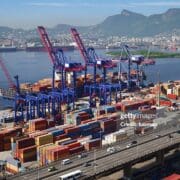Guyana’s Oil Tax
By Candice Dorwish
Special To News Americas
News Americas, NEW YORK, NY, Tues. Nov. 21, 2023: The Guyana parliament’s decision to create – what amounts to – a zero tax clause in the petroleum production agreement keeps power and wealth in the hands of its foreign counterparties and contributes to Guyana’s economic inequality. Additionally, it stagnates the potential for sustainable economic growth here in the local land.
While the Stabroek Block Production Sharing Agreement (PSA) should be analyzed in its totality, a few details worth reading are found in Articles 15.2 – 15.4. The rhetoric inscribed within the agreement places the income tax liability of the multinationals onto the shoulders of the Guyanese taxpayers.
This tax loophole exempts ExxonMobil Guyana Ltd., CNOOC, and Hess (now or soon to transfer to Chevron) from the income tax laws applicable to every other entity doing business in Guyana. This is a monumental financial loss for all things Guyana; the type of revenue that oil taxes are generating should be making positive tangible changes for everyday citizens here in the territory.
Ask yourself: since the beginning of oil production in 2019, has your life or the life of your neighbors improved? Do you feel any richer? Does the outlook on life for your children seem any more prosperous? One can assume your answer to these questions is a resounding “No!” Well, fellow Guyanese, why and how is it that One Guyana, the much-propagandized motto of President Ali, has not been fulfilled?
The question begs, where should Guyana’s tax revenue go? Well, look at the superpowers of the modern world, Russia, China, the United States of America. On their ascent to global primacy, how did these countries direct their own tax revenues? Answer: tax resources were allocated towards advantageous entitlement programs such as education systems, roads and bridges, advanced medical care, and technology, just to name a few. By providing local citizens additional opportunities for economic prosperity, populations of these great nations were able to do more with their lives and, as a result, contributed greatly to the economic development of their respective countries.
More needs to be done by Guyana and its citizens to take an active role in increasing its own share of financial profits generated by offshore drilling. If one wishes to continue drilling into our Exclusive Economic Zone (EEZ out to 200 nautical miles) with complete disregard for the environment, then the answer is simple: an enforced 40% income tax rate on the oil companies. Guyana can maintain a strong mutual relationship with the United States without offering one-sided tax breaks. It is illogical to provide oil tax incentives to an organization that generated US$11.7 billion in free cash flow in Q3 2023 – an increase of US$6.7 billion QOQ (Quarter on Quarter).
Make no mistake about it, Guyana, with its newfound fortunes of oil exploration and future oil reserves, has a once-in-a-lifetime opportunity to make things right for its people. This country is sitting on a liquid gold mine and this “gold” has the capacity to change the lives of every single Guyanese living today, including those unborn in the future. Let this letter be a loud proclamation to the great country that is Guyana.
Take note and hear these words clearly: if you do not pay attention to the vast amount of riches that are at your seashore, at minimum, you will have guaranteed that your children and your children’s children will remain living a life full of uncertainty, and you will have failed at giving them the greatest opportunity that Guyana’s history could have afforded them.







